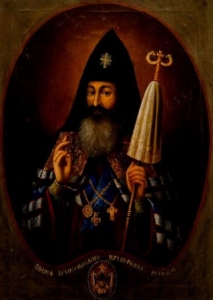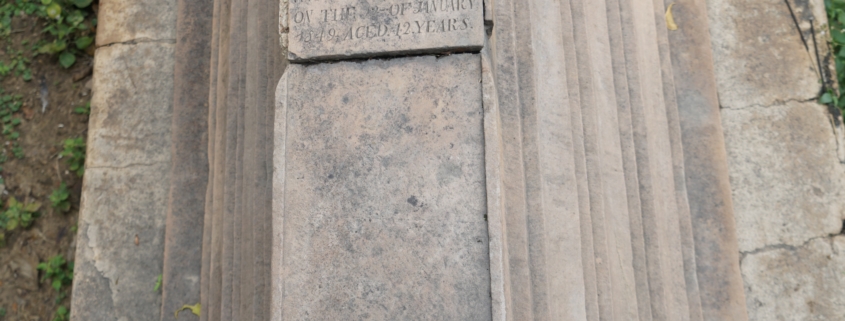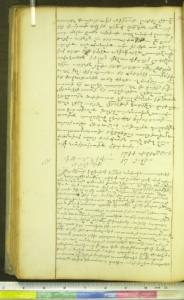A History that has Vanished: Armenians in Eighteenth-Century Kabul
August 19, 2018
Kabul (Afghanistan) during the eighteenth century is not a place one would expect to find an Armenian community, much less one with a church and two priests. Till now, rumors that there were indeed resident Armenian merchants in the capital of Afghanistan with their own community structure were just that, rumors. Mesrob Seth mentions them in his book, but like virtually every claim he makes there are no footnotes or hard evidence, which to me has the same status as hearsay or rumor.1
 Last night, I found a really interesting document that caught me by surprise because it provides the kind of evidence that historians will be hard put to dismiss. I will offer it here with my quick off-the-cuff transcription and translation along with a brief précis of what is known about Kabul’s mysterious Armenians and their vanished history. The document is a brief letter written in October of 1784 from Astrakhan (Ashtarkhan/Աշտարխան in Armenian) by a man whose prolific correspondence (a good deal of which still remains unpublished) I have been sifting through for the last ten days. Hovsep Episcopos Erkaynabazuk Arghut‘ean (1743-1801) was a cultural warrior, community activist, defender of the Armenian church, agent of confessionalism among the Armenians, a Russophile, and ardent enemy of the Mkhitarists and the European/Roman Catholic tradition they represented. He was also the supreme primate of the Armenians in the Russian Empire and the founder of the new Armenian community of Nor Nakhijevan (Rostov Na Donu). Right before his death at the age of 58 in 1801, he was elected Catholicos of All the Armenians but did not live long enough to assume his post.
Last night, I found a really interesting document that caught me by surprise because it provides the kind of evidence that historians will be hard put to dismiss. I will offer it here with my quick off-the-cuff transcription and translation along with a brief précis of what is known about Kabul’s mysterious Armenians and their vanished history. The document is a brief letter written in October of 1784 from Astrakhan (Ashtarkhan/Աշտարխան in Armenian) by a man whose prolific correspondence (a good deal of which still remains unpublished) I have been sifting through for the last ten days. Hovsep Episcopos Erkaynabazuk Arghut‘ean (1743-1801) was a cultural warrior, community activist, defender of the Armenian church, agent of confessionalism among the Armenians, a Russophile, and ardent enemy of the Mkhitarists and the European/Roman Catholic tradition they represented. He was also the supreme primate of the Armenians in the Russian Empire and the founder of the new Armenian community of Nor Nakhijevan (Rostov Na Donu). Right before his death at the age of 58 in 1801, he was elected Catholicos of All the Armenians but did not live long enough to assume his post.
Caption: Hovsep Erkaynabazuk Arghut‘eants‘
Though he collaborated with Shahamir Shahamirian and had regular contacts with the Armenians in India to raise money for his “nation-building” schemes in Russia, he was on the far-right spectrum of Shahamirian and cautioned the latter regarding his mercantile “republican” vision for a future Armenian state and advocated a monarchic solution with special privileges to the landed class of which he was one of the few bonafide representatives (his family was of nakharar/”feudal” background). On the face of it, this right-wing and deeply conservative religious mindset of Arghut‘ean does not make him an endearing figure for me. However, over the last week of reading his private mail and also from two months of deep diving into his work as a printer a year ago, I have come to respect the man’s intellect and commitment to community organizing on a global scale. As his sobriquet Erkaynabazuk (long armed or “longomano” to use the title his Italian descendants are said to have used in the nineteenth century) indicates, his long arm reached across the Indian Ocean to micromanage the affairs of the wealthy Armenians in places like Madras, Calcutta, and Surat. He even cultivated regular ties with Armenians in Batavia or today’s Jakarta from whom he procured large sums to print books on the printing press of his Julfan friend in Saint Petersburg, “Gregor Cojamaul,” aka Khwaja Grigor Khwajamal Khaldarean, the owner of the first Armenian press in the Russian Empire. His arms also evidently reached over the high mountains of Afghanistan to the city of Kabul where there was a tiny community of Armenians some of whom were probably descendants of Nadir Shah Afshar’s (d. 1747) settlement of some 200-300 Armenians there in 1737 or of the fifty Armenian families brought there by Ahmad Shah Durrani (d. 1773) from Mashad or Lahore.2 The letter below does not appear to have been published before and is offered here to those interested in a quick but largely accurate transcription and translation. I have taken the liberty to open up condensed words or abbreviations without noting them with brackets.
Translation:
Written to Ter Hovhanness in K’eapul [Kabul]
From the supreme legate of the Holy See and the primate of all Armenians in the Land of Russia, archbishop Joseph from whom let the following be known with affectionate greetings and love to Ter Hovhannes and Ter Baghtasar my spiritual sons. It has been a long time since I received a letter from you regarding your condition and my eyes are always fixed on your journey [there from here]. We have only heard that Ter Baghdasar has left for Shahjahanabad [Agra, the capital of Mughal India] but we have not heard where he is. We also do not know the condition of the people there; for as you know I sent you two there with the precondition that you reside in Kabul for three years, serve as priests, and educate their sons so that there shall be priests from among them for them, and to send us here their choristers so that after I appoint them priests here I shall make them return there so you may return home to us and tutor the young boys here in the Christian canons and fulfill your obligations before God. You had loaned money to Hadji Saffar and he has paid you back. If you write a letter [to us regarding this matter] write on it in Armenian and Arabic Hadji Saffar’s name and send it to Bukhara so that they may dispatch it to us from there, for there are Armenians even there. I order you first that you offer a blessing among all the people of the community there [i.e., in Kabul]. Second, that you write to us concerning all aspects of their condition, as in, how many families they are, what professions or crafts they have, what the names are of their well-to-do members, whether their sons have literacy or not, whether they have scribes or choristers [tirats‘u] among them, whether or not the profits made by the wealthy merchants [dolvatlu] are placed as charity for their [community’s] welfare, and whether or not you have plans to come home. Write about all of this and send it to us soon. And if you were to ask about our welfare and that of our city [i.e., Nor Nakhijevan], we are in good health till now thanks to the Lord, and the city is in the process of being built, the priests are well, only Ter Ghazar has passed on, your families are healthy and long to see you, and everyone sends greetings to you. Ter Hovhannes- – if Ter Baghdasar happens not to be there, you yourself should write about all aspects of your condition, as I wrote above, and send it to us, so we shall be rest assured. If the people have any woes and wish to write to the Catholicos and to us, make them write it down and send it. Moreover, also write about your condition and the spiritual outcome of your work, and when you are writing a letter, place this letter of ours before you and in that fashion write down your responses one by one.
Be well,
October 17, 1784, in Astrakhan.
Armenian original:
՚Ի քեապուլ գրեցաւ Տէր յովհանէսին
Սրբոյ Աթոռոյն Էջմիածնի Ծայրագոյն Նուիրակ եւ ռուսաց երկրի ամենայն Հայոց ազգին Առաջնորդ յովսէփ արքեպիսկոպոս, յորմէ սիրով, ողջունիւ եւ Աստուածային օրհնութեամբ ծանիք ՚ի քեապուլ եղեալ Տէր յովհաննէս եւ Տեր Բաղդասար սիրեցեալ հոգեւոր որդիք իմ, բազում ժամանակ է, որ ես ՚ի ձէնջ ո՛չ գիր ունիմ եւ ոչ որպիսութիւն, եւ աչքս միշտ ՚ի ծանապարհ ձեր հայի միայն թէ մեք լուաք որ տէր բաղդասարն գնացեալէ ՚ի շահջահանապատ, այլ ո՛չ իմացաք նորա ուր գոլն։ Եւ ոչ գիտեմք ժողովրդեանդ այդմիկ որպիսութիւն, զի որպէս գիտէք, ես ձեզ այն պայմանովն առաքեցի որ դուք երեք տարի ՚ի քեապուլ նստիք եւ քահանայութիւն առնէք եւ դոցա որդիքն կարդացնէք որ իւրեանց միջիցն լինի քահանա վասն իւրեանց, եւ եթէ կարդացող տիրացու կայր առաքէիք ինձ, որ ես տեղս ձեռնադրեալ եւ քահանայ արարեալ յետ դարձուցանէի, որ դուք յետ դառնայիք առ մեզ եւ հետեւիլ որ մանր տղայոցն կարդացնէք քրիստոնէական օրինացն տեղեակ առնէք,որ վասն ձեր մեծ վարձ լինի առաջի աստուծոյ, Հաճի սաֆարին որ փողէիք տուած նա ձեր պարտկն ետ, եթէ գիր գրէք որ դուք ՚ի վերա թղթոյն հայերէն եւ տաճկերէն հաճի սաֆարի անունն գրէք ՚ի բուխարայ ղարկէք, անտի մեզ կու հասուցանեն
տեղն հայեր եւս կան, պատուիրեմ ձեզ, նախ որ ՚ի մէնջ ամենայն ժողովրդեանց օրհնութիւն մատուցանէք։ Երկրորդ զամենայն որպիսութիւն նոցա մի ըստ միոջէ մեզ գրէք թէ որպէս են քանի տուն են, ինչ արհեստ ունին , զինչ են անուանք երեւելեացն, որդիքն նոցա կարդացուցեալ էք թէ ոչ, տիրացու ունին թէ ոչ, դօլվաթլու շահն ողորմութիւն ունի ՚ի վերա դոցա թէ ոչ եւ դուք միտս ունիք գալոյ թէ ոչ։ զայսոսիկ ամենայն գրէք եւ չուտով առաքէք, եթէ մեր եւ քաղաքիս որպիսութիւնը հարցանէք փառք տեառն մեք եմք ՚ի յարողջութեան մինչեւ ցայժմ, նմանապէս եւ քաղաքն ՚ի շինութեան քահանայքն նոյնքն են, տէր ղազարն միայն վախճանեցաւ, ընտանիքն ձեր եւս առողջեն եւ տեսու ձերում կարօտին, եւ ամենեքեան զձեզ ողջունեն, տեր յովհաննէս, եթէ տէր բաղդասարն չլինիցի տեղդ դու զամենայն որպիսութիւն ձեր որպէս ՚ի վեր գրեցի, հարկիւ գրեսցես եւ զմեզ միամտեցուսցես, եթէ ժողովուրդքն ցաւ ունիցին եւ կամիցին գիր գրել սրբազան Կաթուղիկոսին, եւ մեզ, գրել տացես եւ յղեսցես հոգեւոր արդիւնքն, եւ ձեր կացութիւն որպէս է, զայն եւս գրէք գիր գրելոյ ժամանակն, գիրս ձեր յառաջն դնէք պատասխանն այնպէս մի առ մի գրէք։ ողջ լերուք։
17 10 84 ՚ի հաշտարխան
Addendum January 2020:
During my visit to the historic Roman Catholic cemetery in Agra, the historic capital of the Mughal empire and home to a small but thriving Armenian community of merchants from a diverse variety of places across the early modern Armenian diaspora, I came across an unlikely tombstone separated from the other 105 or so Armenian tombstones in this sprawling and well-kept graveside where the dead have much to say about the community of the living. that their dearly departed. Sitting there in its still silence, enclosed a mortuary space to be collected, remembered, and venerated was a simple basalt tombstone of a man from Kabul who had in all likelihood moved to the once splendorous Mughal city and passed away there in the nineteenth century. Though separated from missive sent by Arghut‘eants‘ by more than seventy years, Mr. Zorab Simon was there to remind me that Afghanistan’s best known city was once home to a small but probably commercially savvy diaspora community if Armenians. The tombstone inscription is as follows:
ԱՅՍ Է ՏԱՊԱՆ ՊԱՐՈՆ ԶՕՐԱԲ ՍԻՄԷՕՆԵ[Ա]Ն ՔԱԲՈՒԼՑԻ 42 ՏԱՐԵԿԱն ՚Ի ԱԳՐԱՅ ՎԱԽՃԱՆՎԷՑ ՋԱՆԷՐԻ 12 1849
Translation: THIS IS THE TOMB OF ZORAB SIMEONIAN FROM KABUL, PASSED AWAY AT THE AGE OF 42 IN AGRA ON JANUARY 12, 1849.
ENGLISH TRANSCRIPTION:
SACRED TO THE MEMORY OF MR. ZORAB SIMON OF CABUL AN ARMENIAN MERCHANT WHO DEPARTED THIS LIFE ON THE 12 OF JANUARY 1849 AGED 42 YEARS
Caption: Agra, Catholic Cemetery, Armenian tombstone of Zoram Simon
Photo: Sebouh David Aslanian, December 18, 2019
Footnotes:
- See the interesting account in Mesrovb Seth, Armenians in India: From the Earliest times to the Present Day (Calcutta, 1937), 207-224.
- Jonathan L. Lee, “The Armenians of Kabul and Afghanistan” in From Cairo to Kabul: Afghan and Islamic Studies presented to Ralph Pinder-Wilson, edited by Warwick Ball and Leonard Harrow (London: Melisende, 2002), 157.










